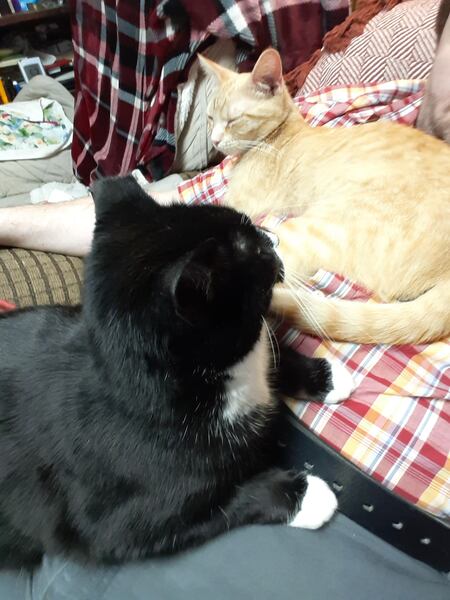
If you go online to learn knots, you will see lots of videos (from outdoorsy people) and lots of craft videos, and several encyclopedias of knot pictures and instructions. There are people doing research into knots, new and old. There are specializations in knots for caving/climbing/rescue, crafts, outdoorsing, and fishing.
With the risk of becoming one of those "Six knots everyone should know" articles like one tends to find a million of everywhere, I would prefer to give a focus on what the 'normal' sort of person, like my students, would need, and resources to learn about them. Most of these are just results from a judicious google/bing/duck search, or marganilia [https://search.marginalia.nu/]
My recommendation for future knot learners: Presuming you will have a cell phone or a computer, find a reference you like and bookmark it. When you find a problem with cordage, look for a particular knot for a solution. If it fails, look for another. If you are relying on cordage for life support, such as climbing or rescue, or using knots for work, or applying high forces, then learn the knots in a low-stakes situation first. Shoestrings and climbing ropes are not the same. The best thing you can do to learn knots is to work on them as play -- pick up a source and a string and have fun, or meditate. you want to be able to tie a few knots without thought.
| Join two cords | Bends | Grapevine Knot, specific purpose knots (do not take this lightly) |
| Fixed loop | Loops | Bowline, Butterfly Loop, Perfection Loop |
| tightening loop | Nooses (can be made from Loops) | Scaffold Knot, Grapevine Loop / Double Overhand Loop, figure-8 noose |
| Wrap around and keep secure | Binding Knots | Constrictor Knot, Butcher's Knots, Hitching |
| Tie to object | Hitches | Pile hitch, Larks Head, Groundline Hitch, Mooring Hitch |
| You already know these | Basics | Overhand Knot, Overhand Loop, Slip Knot |
If your favorite knot isn't here, you should teach it to someone. There are so many knots and specializations; the goal here is that some knot will be useful, not perfect, and maybe one can avoid confusion. Again, you should not learn life-critical knots from some guy on the internet. This is not that kind of advice.
The Ashley Book of Knots, by Clifford Ashley, is the reference text for knots of all sorts. Many references to knots will also give the ABOK reference number. Not everything is there, but if there is something you can do with rope or string, you can find a way of doing it there.
Low-tech magazine has a good article on the history of cordage and the development of alternativesSchool is ongoing, and one small bit of work is learning python enough to slow numerical integration / simulation of physics things. Another is processing data gathered with arduino and sensors in python.
One problem im working on is a demo of what I remember as the 'monkey and hunter' which shows that all things in freefall see the same acceleration (and so things moving with horizontal velocity also fall. The trick is to aim a projectile at a target directly, and drop the target upon firing, so that you show the projectile falls at the same time as the target. My current setup is an electromagnet and relay, triggered by an old photogate; the ball is too fast to drop the target, so it needs a 555 timer in monostable mode. My sentence tool over 3 minutes to load after typing it.
School started around August 1st. Preparation has been focused and time consuming. There is also internet problems and work. I cannot even reliably finish these sentences due to internet latency; this is an ephemeral postto be updated with actual work-related research later.
Warning - American-centric bullshit Privately made firearms have always been a thing. The limitation has been materials and knowledge, which ends up being a time/money/risk tradeoff. Years ago, there was the 'scare' of 3d printing firearms, which at the time looked to me like the proliferation of hand-removers. At that time, hardware stores had done more to provide access of firearms to all.
People kept working on it though, and they were benefited by laws that are, frankly, stupid (but probably a product of time; about 1930-1970). The hardest part of a firearm to construct is the pressure-bearing components, which is why many early [post-1930, late 20th century, etc] and popular designs of PMFs were iron-pipe slamfire shotguns (low pressure, easy parts, shotgun accuracy), or designs straight out of army manuals. Of course there are parts kits and other sorts of arms that can be assembled, rather than manufactured. (think lego vs. woodcarving). However, the parts of a firearm that are regulated are not always those hard-to-get parts; generally you can buy barrels and some combination of parts without having bought a firearm; other parts are, according to the law, the regualated firearm.
As an aside, if you were to consider the manufacture of a firearm, it is imperative that you know what you are doing, both as an engineer and as a law-abiding citizen. I am neither your lawyer, nor your engineer, and you should not take anything written here as advice or instruction. You can very easily build something illegally without knowing it if you do not know all of the relevant laws. You can also blow your damn hands off.
Because some 'firearms' are non-pressure bearing parts, they can be easily 3d printed and then assembled with unregulated parts. The Internets has lots of info on what people have built and tested. It is quite interesting to me; they make these devices that are legal, but clearly playing "i'm not touching you" with revenuers. Other ones are just cheaper forms of expensive firearms, making them affordable to more people. That is a theme i see in all these, that everyone should be able to be armed.
The one bit that is generally never manufactured has been the barrel; for many designs it has to be rifled to be legal, and that requires more machining work than the average person can manage. In America (USA USA USA!!!) spare part / upgrade part barrels are commonly available, along with barrel blanks and liners for fixing or rebarreling older firearms. At home machining would require lathes that can accomodate the barrel length and special tools to cut the rifling; this is something people rarely have space or money for. This is now a defeatable obstacle, as techniques have been formed to electrochemically machine rifling and barrel features.
Electrochemical machining (ECM) is basically reverse-electroplating. One uses conductors positioned along a workpiece and salt water to attract material off the workpiece using electric current, and circulation of water removes material leaving machined features. 3d printed tools allow positioning of the conductors, allowing rifling and chmbers to be machined into commodity pressure-bearing tube. This can be used for more than just firearms, though in this rabbit hole, this is the big application.
There is at least one design that is basically manufacturable at home, and would be considered a 'legit' firearm, rather than some form of zip gun or pipe shotgun. ECM'd barrels, printed parts and receivers, and store-bought springs. (Looks ugly as shit too, but it works)
~~~~~~~~~
I don't know what the future will entail. I know that there will always be people who want to throw rocks at high speeds, and want to make loud noises, and will have need, legitimate need, for that. There will also be dangerous, irresponsible people. Firearms are a tool, with no room for error or malfeasance; people can die when it works as intended, and quickly. People can die when it fails to work, and when they cannot make use of it as well. It's not like we don't regulate weapons; only the government gets nukes, explosives are limited, machine guns are de facto limited to the rich who can afford them, and arcane laws determine what the average person can have. And yet, we have more guns than people in 'Merica, and we have too many people misusing them, shirking responsibility, and ....
If you would say that "it's not guns, it's X, then it is high time that we actually work to fix X, not just repeating that statement everytime a busload of kids are obliterated. You have to, at some point, separate the dangerous people from the dangerous things.
And that is why
'Under no pretext should arms and ammunition be surrendered; any attempt to disarm the workers must be frustrated, by force if necessary'The dangerous people are not just trying random acts of terrorism, they are also trying to take control of us. It's on the television every day, on the internets, in the streets; they want to take from us today, and put themselves back in a world that never existed outside of their minds, and we are somewhere between 'raw material for capitalistic enterprise' and 'trash to be liquidated'.

(the australian outback, i think, image from the internet, i got it from the somethingawful forums, let me know if you want credit)
There is no cell service in this picture, except for the focus of this dish, which is forming a 100km or so whispering gallery with the nearest cell tower. Sometimes the best amplification is receiving more signal in the first place.
The wavelength of the signal / antenna size on the cell phone is on the order of inches; the receiver is good, but can't pick up signal that isnt there. Having a reflector on the order of feet across makes way more signal that wouldn't have been received available. I need a setup like this for my phone hotspot (except for the bit where my phone is tethered to one spot and not right beside me. *shrugs*)
~~~~~~~~~
Do we really need more image formats? This image was originally a webp, which i have no idea about; i umderstand bmp, jpg, gif, png, svg, and raw, and 'historical formats', but i've seen two new ones that bug the crap out of me. Students would send me phone pics of their work for feedback, in heic encoding (thanks apple), and i couldn't open them. Now, the wretched hives have webp images, why? If i need to save an image in these formats, I also have to convert them, which means re-researching how. *sigh*
Frances has decided to lay on my chest while Rusty lays on my right arm. My typing poistion is restricted.
I used the site above to look for info on derivatives, which gave me some interesting math sites (which tend to be clean and simple), and some were old, and HOLY HELL DOES OLD HTML MATH SUCK!!! it is atrocious beyond belief, and we have really come along way so that you can have MathJax and LaTeX -> gifs and whatnot. What i don't understand is why typewriter math, like i've seen in pdf scans, look so much better.
I found this site "MTH 271" which is an online set of lecture notes for mathematical computation with python. Python is right at the limit of my abilities to program, in the sense that I could do C (microcontrollers and computers) and pascal and basic and bash and matlab and awk and perl a long time ago, but i can't yet do the modern languages like haskell and whatever the hell rust is and similar, because i can't understand any of the material for beginners. Python has just enough clarity that i get things like iterators and generators and list comprehensions enough to know what to look up or can make a thing do. ignore old man rant; also all i ever seem to do anymore is LaTeX and HTML
The math site has an interesting lecture note on numerical approximation of derivatives. We tell students that derivatives are slopes of a function, and slopes are rise / run, but never seem to tell them that if you don't know what the function is, and jsut have some data, just feckin do rise/run, dude! At least, I don't remember this in calculus and i had the four-semester version with numerical integration and root finding and all the stuff kids miss nowadays; I see kids learning good things with numerical work and approximation and such, but this one trick seems to have skipped out. Eh.
This week has been full of thunderstorms and summer chores and at night All Of The Cats have to lay across my body / work area and get attention. Frances is extra demanding of sleeping directly on me nearly all the night. Normal during the day, of course; and she makes it difficult to sleep.
I also tried to figure out a way to have a changing stylesheet on this page, but i didn't want to use javascript, so no luck so far. If you know a way, email me please.
I tend to have a weird population of physics students; some are taking Calc 3 (multivariable and vector) while others are taking Calc 1 (derivatives). Possibly all will be deficient in algebra compared to when I took physics [especially thanks to The Unprecedented Situation We All Find Ourselves In (COVID)].
So, what I am working for is some sort of ... well, not an easy way out, but something where students can know just enough to start; knowing they will get the proper math methods later. Last year I think I did ok with algebra -- get to students to solve systems of equations that they don't retain or don't cover. This year I want to add calculus, as would be needed for physics.
Anyway, this is what I want to develop on. Define the differential: for y = f(x), dy = f'(x) dx, determined by replacing y --> y + dy, x --> x + dx, and then taking the first-order approximation in dx, dropping all higher powers. I think that that might be more accessible; explain that what we want in physics is to see rates of change; if we make a little change (x+dx), how does the function change (y+dy) and our derivative dy/dx really is a division of two small changes. [note: vid linked below, one must be careful with differentials manipulation, things are only approximately equal unless everything is at one one point, dx is infinitesimal.]
To be clear, this is just changing perspective on the math method, but the goal is to deliver it in a useful method for what i'm trying to do. The bits I want to remember are from these references:
Also in my lazy research, I found these lectures from MIT OCW on calc. Hanev't looked at them yet, these are just for later reference for me. I think this approx and infin. is what I'm looking for above, but i can only read transcript with tonight's internet connection. Thanks, capitalism.
~~~~~~~~~~~~~~~~~~~~~~~~~~~~~~~~~~~~~~~~~
Rolle's theorem states that (to paraphrase) if you have a continuous function f where f(a) = f(b), then there must be some point c between a and b where f'(c) = 0.
In physics, there is often a need to find the 'turnaround point', where the motion of an object reverses direction. Think of an object tossed into the air: "What goes up, must come down". There is a function f which describes the position, and a derivative f' describing the velocity (in that direction). Since the object covers a path that will have the same position [f(a) = f(b)], there must be a point where the object turns around, and at that point, the velocity is zero (f'(c) = 0).
There is a lot of information online, and some of it is in a useful state. One of those unusual fonts of info comes from the old fashioned way of research -- asking a librarian. the Library of congress has some people who will try to answer questions, and they have a frequently asked question list.
My favorites:

What I want to remember out of this video is the method of detection of vibration -- Matthias uses a speaker with a weighted cone as sort of a microphone. Measuring the signal with an oscilloscope / spectrum analyzer makes finding vibration frequency fairly straightforward. Can this be used along the lines of makeshift seismometers (generally the voice coil being moved around a magnet through some resonant system, like a pendulum.)?

Ellipses are very ill defined in mathematics, but this is the first time i've seen ellipses abused to explain using math something about the 'nature' of the universe. The places where I saw this use of ellipses most commonly is
In the image above, note that a number of the form x = 2^n -1 in binary should be all 1's, if you have an infinitely long number of this sort, it will be an infinite line of 1's (...111). 2x must be an even number, which would end in 0 in binary (...110); the ending position is for 2^0 = 1 which determines parity (1=odd, 0=even). However, since it is infinitely long, all you have really done is subtract 1 from x (...111 - ...001 = ...110); 2x = x - 1 --> x = -1. In computer numbers, this would indicate that 2^N is the most-negative number you can have, your number type overflows at 2^n -1. This is the behavior of two's complement computers; see [Wikipedia -- Two's Complement] This sort of implies that ellipses to the left of the decimal point (and, semi-jokingly, algebra and the universe) work like math on a two's complement machine
While preparing this, my cat Rusty would like to share his thoughts on the matter below:
tgyyyyyyyyyyyyyyyy5555555555555555555555555555555555555555 j ju888888 vfffffffffff?fffffffffffffffffffffffffffffffff nnnnnnnnnnnnnnnnnnnnnnnnnnnnnnnnnnnnnnnnnnnnnnnnnnnnnnnnnnnnnnnnnnnnnnnnnnnnnnnnnnnnncccccccccccc m njmhy



Also, I don't think people know when to use raincoats or umbrellas. I see people with umbrellas out and open with barely a drop falling, and people with nothing in a downpour repeatedly. I don't know where to find a good raincoat; I generally get whatever's around. Also I don't mind a little light rain. Or waiting out a downpour. I kinda think people forgot how to deal with weather. Not everyone; people know what works for them, I guess, but I can't understand the variety of responses. I don't know where rain goods are sold; maybe I haven't been to the big city to see something that isn't a crap box store.
You see, the spare I have is a 'donut' like probably everyone else, unless your car is a jeep sort of thing or from 1985 or earlier. You should not run the donut on a drive or steering wheel. (the donut shouldn't exist, but c'est la merde). I always get my flat tires in the worst ways; today it is the driver's front tire on a FWD car in a parking lot in 90 degree, no-shade, beautiful weather. I wasn't far from home and it was easier to do it wrong and safely creep the car home where I could do it right in cooler evening weather.
Anyone can have the knowledge to change a tire, but it's not an easy thing. Actually removing the tire from the hub is easy, the strenuous part is getting the lugnuts loosened and raising the car on the jack. That is the work.
I am not a mechanic; I am not your mechanic. I'm just going to list things that I found useful in a precarious situation, or intend to have next time.
~~~~~~~~~
I grew up in what one might refer to as 'shitkick holler', and still live there. This is the home of the 'freedom-loving rugged individualist', so let a resident tell you now that trying to be a freedom-loving rugged individualist is a great way to die alone in a ditch. No one is an island to themselves; we all need community. In the example above, a driver should have three people who can help them; without them, you would be alone changing a tire on the side of the road, or walking home.
Think of all the people who might think of themselves as 'rugged individualists' -- they generally rely the most on the community around them. People to deliver food and fuel and medicine to where they can get it. People to maintain infrastructure. People to entertain them, and to care that they live.
Now think of the people who claim they are 'freedom lovers'. What do you think they feel about your freedom? In my experience, to mangle a song, they think freedom is making sure you have nothing left to lose.
~~~~~~~~~
I am typing this on the tilde.club server, tmux'ed and over an ssh connection, which goes through my phone hotspot to the greater internet. This afternoon, there was significant latency, such that I could type several words, then wait ~30 seconds for them to appear. I learned that if you have vim mappings that look like <leader><keys>, the leader can timeout before the keys arrive to be read, and it can do unintended changes.
I have a keybinding, \sv that tells vim to reload .vimrc. I was editing .vimrc, and testing the changes in another document, which kept seeing a letter change to a v -- vim was seeing <leader><timeout> substitute letter (s) with v. In those cases, remapping keys to avoid the <leader> key is likely better. Or, just run the command yourself. ( :source $MYVIMRC ) Also, bitten again by trying to put literal angle brackets in html. Damn.



This page has a textwidth of 64em, blatantly copied from the tilde.club css file. I haven't changed it because the text is intended to be as readable as a book, which generally has about 65 characters in a column (this is the 'default' setting in TeX typesetting, and it matches my experience with normal books. I don't know about textbooks.)
This isn't an attempt to make a mobile-friendly website, and I don't know how it would look on a phone. Good luck, phone-internet users. I'm also not optimizing for desktop; I don;t want to install new browsers and check how it looks; it seems ok on firefox and dillo, though they disagree on rendering the page.
An aside, Debian 11, why isn't dc a default install program?
tmux worked out of the box. tmux can work, but you have to have your shell understand that it can do 256 colors. For me, that was adding
export TERM=xterm-256colorto my .bashrc. Anyway, thank you, tmux. Now I have to get used to C-b instead of C-a, but i'm also getting used to things I remember from 20 years ago being subtly different than my memory. Thanks, time!
In vim, you can run a command and then read the result into your file using :r! nnoremap <F2> i<CR><ESC>k:r!date +\%Y-\%b-\%d<CR><ESC>kJJ<ESC>
Do not add things to your .vimrc that you do not understand. This maps the F2 key to a series of commands; the extra movement commands put the text exactly where I want it, not on a new line; you split the line, add the date, then rejoin the three lines you have. I am sure there is a better way, but I'm still learning. For example, you have to enter the tag brackets with &-escaped text in HTML (see source). Thanks vim macros and stack overflow!
As an aside, my current internet connection is bad, and I can type much faster than the screen can display. Vim is maybe designed for this (I have never used a 300 baud connection on a dumb terminal); if you are editing and know you made a mistake in vim too far back, stop and go to normal mode. Then search (? or F) for the mistake in the line, and fix it, then re-enter insert mode with 'append at end of line (A)'. (If you error spans from some point to the end of the line, use substitute to eol (S). I never did learn touch typing, or the habit I saw them learn of hitting backspace, then retyping. Type only once.
A further aside, if you bold and italic text in vim, it might change the highlighting on it, be not afraid if you haven't closed your tags yet. (Do close them, I guess)
One more; don't put the first paragraph in <p> tags. It leaves unsightly space. I don't know why. Bit again by the literal < >; don't write at logical bedtime.
I can't really call it the end now, can I? I'm starting here and appending to the top of the doc.